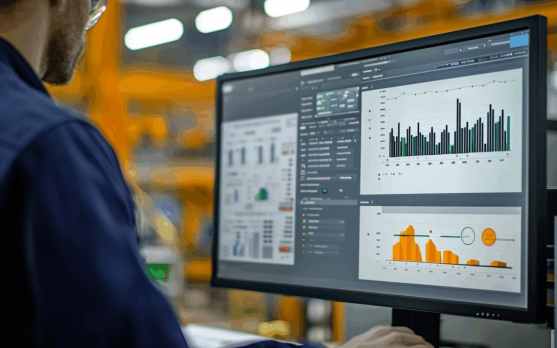When AI Doesn’t Wait for Instructions: Agentic Systems in Frozen Food Factories
In the world of frozen food production, every second — and every decision — matters. There’s no room for hesitation when fries are flying down a line at 60 meters per minute, or when a freezer hiccup could ruin 12 tons of product. That’s exactly why a new kind of artificial intelligence is stepping onto the factory floor: not to follow orders, but to think, decide, and act — on its own. This is agentic AI. And it’s not just a tech upgrade. It’s a shift in how food manufacturing works.

It Doesn’t Just React — It Thinks
Let’s make one thing clear: this isn’t the usual automation. You already know what that looks like — timers, logic gates, sensors that say yes or no. Agentic AI goes further. It looks at the entire system, notices patterns, predicts what’s coming, and then decides what to do. It doesn’t need someone to tell it that a batch of potatoes is running wet — it knows, and it adjusts the slicer blades and frying temperature before anyone’s checked the dashboard.
In fact, it does something most systems never could: it adapts. Constantly. If your packaging line slows down because a roll of film is sticking, the AI might shift flow to another lane, change output timing, or even reassign robotic arms to cover the delay — without human intervention. It doesn’t replace operators. It supports them with something better than logic: context.
Proof It’s Already Happening
Let’s move past theory. In one facility near Namur, Belgium, a well-known producer of frozen vegetables integrated agentic AI to oversee blanching and freezing in tandem. The AI learned from historical throughput data, weather fluctuations (affecting produce moisture), and even shift performance. Within eight weeks, unplanned downtimes dropped by 26%. The AI wasn’t told what to look for — it figured it out.
Meanwhile, in northern Italy, a mid-size processor of frozen ready meals installed agentic software to manage changeovers between SKUs. What used to take 40 minutes and a supervisor now happens in under 20 — and happens differently depending on the line, the day, and even the operator behavior. The AI adjusts its actions based on patterns it recognizes — like a manager who’s watched the same crew work a thousand times.
The Cold Room Is Getting Smarter, Too
Cold storage has always been energy-hungry. But agentic AI is changing that equation. In one pilot with a private-label potato products plant in the Netherlands, AI agents learned the “breathing rhythm” of the plant: when the lines ran hard, when loads peaked, and when compressors could ease off. After two months, energy consumption was down 14%, with no compromise in temperature stability.
Here’s the kicker: the AI didn’t follow preset logic. It decided when and how to act, based on its own understanding of real-time conditions — something even experienced engineers admit they couldn’t replicate manually without hours of monitoring.
Packaging That Adjusts on the Fly
If there’s one place where flexibility matters most, it’s packaging. Especially with frozen goods, where sealing, coding, labeling, and boxing all need to work in sync. Agentic AI is stepping in here too, learning how each product behaves, adjusting on the go, and even predicting when something’s about to go wrong.
One major producer of frozen fries in Germany has started testing AI agents on its end-of-line packaging robots. When a run of thinner bags begins causing fold issues, the system slows the belt slightly, adjusts grip pressure, and flags maintenance — all before a single pack goes to waste. The line supervisor gets a notification, but the fix is already in motion. That’s not automation. That’s awareness.
It Knows When to Call for Help — Before Things Break
No one likes breakdowns. But it’s not the failure that hurts — it’s the surprise. Agentic AI changes the timeline. It listens for micro-vibrations, watches current draw, analyzes pressure curves, and, before something snaps, it whispers: “This fan’s going to fail soon.”
At a frozen fish packing plant in Norway, a predictive AI module now handles compressor diagnostics. The result? A 60% reduction in emergency calls, because the AI knows what’s coming. It doesn’t panic. It just tells you what’s next — and gives you time to act.
What’s Stopping Everyone From Using This?
Honestly? Mostly infrastructure and mindset. You need clean, connected data — not USB drives. You need a workforce that sees AI as a partner, not a threat. And you need a little faith in systems that do things differently than we were trained to expect.
But those barriers are dropping. More OEMs now build “AI-ready” machines. More platforms are integrating agentic modules out-of-the-box. And more food manufacturers — big and small — are realizing this isn’t science fiction. It’s here. It works. And it's worth it.
Final Thought
We’ve spent years perfecting machines that follow instructions. Maybe it’s time we built systems that *don’t* wait for them. Agentic AI doesn’t just help frozen food producers do things better. It helps them see problems before they appear, act without hesitation, and evolve with every batch. That’s not just smart. That’s human.
Conclusion
Agentic AI is more than the next step in automation — it’s a shift toward autonomy. And in the frozen food world, where precision, timing, and adaptability make or break margins, that shift is already underway. The smartest factories aren’t waiting for the future. They’re building it, batch by batch.
Essential Insights
- Agentic AI adapts, thinks, and acts — no pre-programmed logic needed.
- It’s already reducing waste, downtime, and energy use in real frozen food factories.
- From predictive maintenance to smart packaging, its impact is measurable and growing.
- The main barriers today are infrastructure and mindset — not technology.




